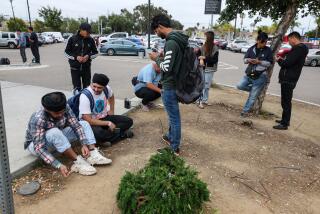Residents, Firms Urge Overlay Be Put on Hold
- Share via
VAN NUYS — The message from residents and business owners attending a town hall meeting Thursday night on a controversial area code relief plan for the San Fernando Valley was unmistakably clear: Delay the overlay.
About 65 people gathered in the auditorium at the State Building in Van Nuys to question state regulators on their plans to implement an area code overlay that would require all callers in the Valley to dial 11 digits for local calls.
For the record:
12:00 a.m. Aug. 7, 1999 For the Record
Los Angeles Times Saturday August 7, 1999 Valley Edition Metro Part B Page 3 Zones Desk 2 inches; 63 words Type of Material: Correction
Area codes--The United Chambers of Commerce of the San Fernando Valley has clarified its position on a possible area code overlay in the 818 calling area. Chairman Ross Hopkins said Friday the group prefers an overlay to a geographic split, but wants to explore other alternatives, including a proposed one-year delay in implementing the overlay. Vice Chairman Richard Leyner had previously told The Times that the business group opposed the overlay.
At the meeting, state Sen. Richard Alarcon (D-Sylmar) and Assemblyman Wally Knox (D-Los Angeles) called for delaying any overlay for at least one year.
“If we make no changes at all, we will have sufficient numbers for another year,” Alarcon said, citing state estimates of the number supply. “I don’t believe that sufficient evidence has been presented to move forward on an overlay or split.”
Public Utilities Commissioner Carl Wood said he wants to delay the 818 overlay until he is presented with irrefutable evidence that there is a number shortage.
“If it’s necessary to delay a decision to get a good decision, I will work to make that happen,” he said.
Telephone companies say an overlay is necessary to accommodate a surge in demand for additional phone lines for computer modems, fax machines, cellular phones and pagers.
But critics argue no one knows how many numbers are actually being used, since numbers are allocated to phone companies in blocs of 10,000 and phone companies refuse to say how many of their numbers are assigned.
Overlay critics want telephone companies to open their books to prove claims they are running out of numbers in the 818 calling area.
The overlay is being actively opposed by groups and individuals, including the United Chambers of Commerce of the San Fernando Valley, Encino Chamber of Commerce, City Atty. Jim Hahn, the Los Angeles City Council and the Board of Supervisors.
Los Angeles Mayor Richard Riordan, meeting with Los Angeles Times editors and reporters in the Valley on Thursday, also voiced skepticism of phone company assertions that the overlay is needed.
Strong public opposition prompted the five-member Public Utilities Commission to defer action on the overlay proposal until after the town hall meeting.
The overlay issue will most likely be taken up again at the panel’s regular meeting Sept. 2, when the commission could approve an overlay, split or another alternative.
At Thursday’s meeting, residents and business owners joined Alarcon in pressing for a delay.
“A delay is really important because we need to have efficient utilization of telephone numbers,” said Gerald Silver, president of the Encino homeowners association.
Silver also said telephone companies should be assessed a fee for each phone number in their possession that has not been assigned in a timely manner.
The overlay is being supported by Pacific Bell and GTE Corp., which say it is preferable to splitting 818 into two new area codes. Neither company’s representatives spoke at Thursday’s meeting.
But Arthur Sweet, a North Hollywood businessman and an officer with National Small Business United, said his organization preferred an overlay to a split because of the costs associated with changing stationery, advertising and Web pages to reflect a new area code.
“If we have costs that go up, we are concerned that we may have to let people go,” he said. “This could be an employment-killer.”
Sweet said the organization is willing to consider alternative plans and would support delaying the overlay.
The Valley Industry and Commerce Assn., a powerful organization that represents hundreds of Valley businesses, also came out in support of the overlay Thursday, after initially saying it wanted an alternative to both the overlay and the split.
“For the past year, VICA has been exploring the issue of area code relief, and has come to the conclusion that an overlay is, indeed, the preferred method,” association spokesman Scott Schmidt said.
Alarcon asked the group to support the delay.
“I would request that VICA support any effort to delay a decision until it is absolutely clear that there is a shortage of numbers,” Alarcon said.
The senator encouraged those in attendance to write, call and e-mail PUC commissioners and elected officials to register their opinions.
In other action Thursday, Knox and Assembly Speaker Antonio Villaraigosa (D-Los Angeles) sent a letter to PUC President Richard Bliss urging him to drop plans to implement an overlay for the 310 area code in West Los Angeles and the South Bay.
“In terms of content, the commission’s decision accepts virtually every point made by the petitioner, then comes to the irrational and unacceptable conclusion that the commission’s original decision instituting the 310 overlay and 11-digit dialing cannot be corrected,” the lawmakers wrote.
Knox and Villaraigosa said they will “pursue every available avenue to ensure that this proposed decision is not adopted.”
More to Read
Sign up for Essential California
The most important California stories and recommendations in your inbox every morning.
You may occasionally receive promotional content from the Los Angeles Times.










